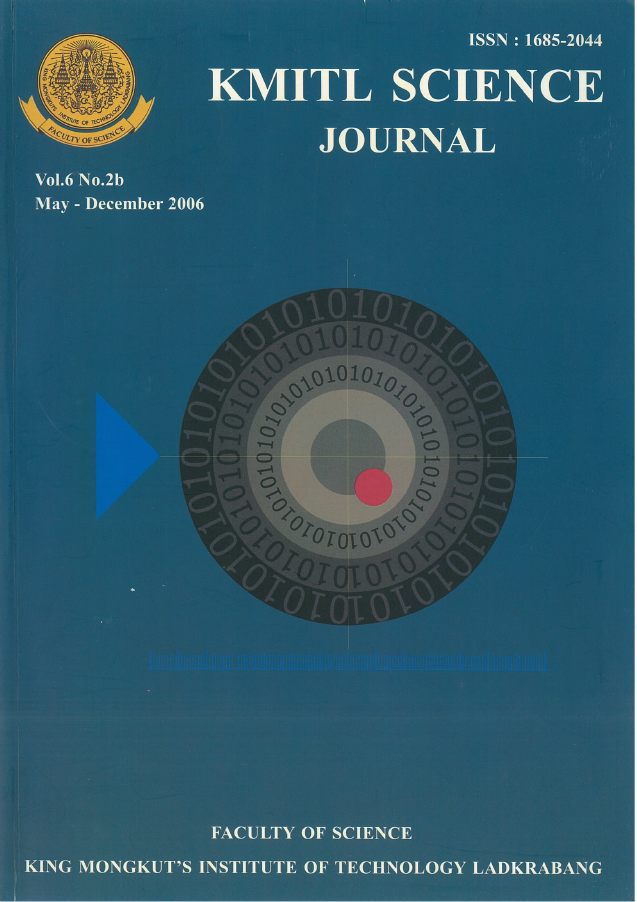Metal-Insulator Transitions in CuInGaO4 and CuIn2Ga2O7 Homogeneous Phases
Main Article Content
Abstract
The compounds CuInGaO4 and CuIn2Ga2O7 crystallize in the (LnFeO3)nFeO layer structure. In this paper, the electrical properties of CuInGaO4 and CuIn2Ga2O7 ceramics prepared by solid-state synthesis were examined. Both compounds exhibited a dramatic change in physical properties across a second-order phase transition at 226 K identified by calorimetry experiments. Above this temperature, the conductivity increased over four orders of magnitude and the relative permittivity increased and became strongly dispersive. These observations are explained on the basis of a hole-hopping mechanism in the Cu layers within the (LnFeO3)nFeO cystal structure.
Keywords: Ceramics, Electrical properties, Electroceramics, Semiconductors
Corresponding author: E-mail: naratipcmu@yahoo.com
Article Details
Copyright Transfer Statement
The copyright of this article is transferred to Current Applied Science and Technology journal with effect if and when the article is accepted for publication. The copyright transfer covers the exclusive right to reproduce and distribute the article, including reprints, translations, photographic reproductions, electronic form (offline, online) or any other reproductions of similar nature.
The author warrants that this contribution is original and that he/she has full power to make this grant. The author signs for and accepts responsibility for releasing this material on behalf of any and all co-authors.
Here is the link for download: Copyright transfer form.pdf
References
[2] Kato, K., Kawada, I., Kimizuka, N. and Katsura, T. 1975 Crystal structure of ytterbium ferrate (YbFe2O4) Zeitschrift fuer Kristallographie, Kristallgeometrie, Kristallphysik, Kristallchemie 141, 314.
[3] Malaman, B., Evradrd, O., Tannieʹres, N., Courtois, A. and Protas J. 1976 Crystal structure of the phase Yb2Fe3O7 Acta Crystallographica, Section B (Structural Crystallography and Crystal Chemistry) 32, 749.
[4] Roesler, A., Reinen, D. and Anorg, Z. 1981 Cu2+ in trigonal-bipyramidaler Koordination: Die Struktur des CuGaInO4 Zeitschrift für anorganische und allgemeine Chemie 479, 119.
[5] Tanaka, M., Akimitsu, J., Inada, Y., Kimizuka, N., Shindo, I. and Siratori K. 1982 Conductivity and specific heat anomalies at the low temperature transition in the stoichiometric YFe2O4. Solid State Communication 44, 687.
[6] Cann, D.P. and Randall, C.A. 1996 Electrode effects in positive temperature coefficient and negative temperature coefficient devices measured by complex-plane impedance analysis Journal of Applied Physics. 80, 1628.
[7] Shannon, R.D. 1976 Crystal Physics, Diffraction, Theoretical and General Crystallography Acta Crystallographica Section A 32, 751.
[8] Zheng, X.G., Xu, C.N., Tanaka, E., Tomokiyo, Y., Yamada, H., Soejima, Y., Yamamura, Y. and Tsuji, T. 2001 Evidence of Charge Stripes, Charge-Spin-Orbital Coupling and Phase Transition in a Simple Copper Oxide CuO. Journal of the Physical Society of Japan, 70, 1054.
[9] Zheng, X.G., Yamada, H., Scanderbeg, D., Maple, M.B. and Xu, C.N. 2003 Effect of hole doping in LixCu1-xO. Physical Review B, 67, 214516.
[10] Vander Griend, D.A. and Poeppelmeier, K.R. 2001 Umbrella stoichiometry: a guide to the solid state chemistry of copper-rich oxides, International Journal of Inorganic Materials, 3, 1277.
[11] Vander Griend, D.A., Boudin, S., Caignaert, V., Poppelmeier, K.R., Wang, Y., Dravid Azuma, V., M., Takano, M., Hu, Z. and Jorgensen, J.D. 1999 La4Cu3MoO12: A novel cuprate with unusual magnetism, Journal of the American Chemical Society, 121, 4787.
[12] Vander Griend, D.A., Malo, S., Barry, S.J., Dabbousch, N.M., Poeppelmeier, K.R. and Dravid, V. 2001 La3Cu2VO9: A surprising variation on the YA1O3 structure-type with 2D copper clusters of embedded triangles, Solid State Sciences, 3, 569.


